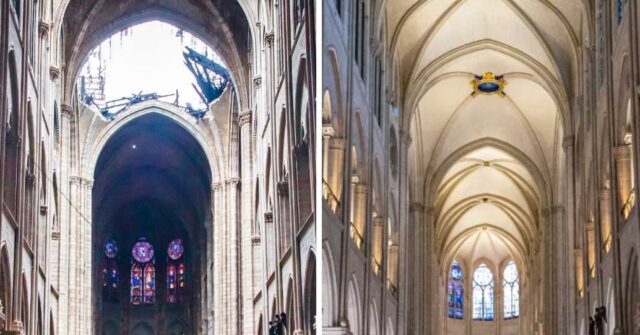French President Emmanuel Macron celebrated the remarkable restoration of the Notre Dame de Paris cathedral ahead of its scheduled reopening on December 7, 2024, nearly six years after a catastrophic fire severely damaged the iconic structure. Taking a final tour of the site, Macron met with the craftsmen and artisans—approximately 1,300 out of a total of 2,000 workers—who dedicated their skills to this monumental renovation, which was described by Macron as “the construction project of the century.” The firefighting efforts on April 16, 2019, had devastated the cathedral, burning through its roof and causing the historic spire to collapse, thus triggering a national sense of loss and urgency for restoration.
During his inspection, President Macron praised the dedication exhibited by the workers, stating they had transformed what he called “a national wound” into a testament to resilience and craftsmanship. As he walked through the cathedral, he noted how the newly cleaned “blond stone” had restored a sense of warmth and welcoming to the majestic structure, which now gleams in its post-restoration glory. The cathedral is rejuvenated from the charred remains it had become, marking a significant milestone not just for Paris but for global heritage conservation.
Part of Macron’s visit included a closer look at the reconstruction of the spire, which had initially sparked a debate regarding potential new designs. While some had proposed modern interpretations that reflected contemporary Paris, the decision was ultimately made to reconstruct the spire as a replica of the original design from the 1850s. Despite the adherence to tradition for the major structural components, the cathedral has shone through with modern artistic touches, including contemporary furniture designed by Guillaume Bardet.
However, the turnaround has not come without scrutiny, particularly concerning the broader issues of fire safety and cultural preservation amidst renovation works. French historian Didier Rykner highlighted notable red flags regarding the safety protocols that were ostensibly lacking during the ongoing restoration before the fire. He criticized the French government for not adequately addressing fire safety measures, which he claimed could have prevented the blaze that nearly destroyed the cathedral. Questions linger regarding the surveillance and monitoring mechanisms that were in place at the time of the disaster.
Rykner’s informed concerns underscore a vital discourse on stewardship of historical sites, especially those undergoing restoration. He expresses frustration over insufficient personnel to monitor the construction site during renovation, indicating systemic issues that could lead to similar catastrophes in the future. This situation raises alarms across the professional community managing world-class heritage sites, emphasizing the balance between modernization efforts and the preservation of historical integrity.
As the reopening date approaches, a weekend of ceremonies is planned to celebrate the restoration of Notre Dame. The event not only signifies the physical rebirth of a historical landmark but also serves as a moment for collective reflection on the responsibilities of protecting such heritage. With insights drawn from the Notre Dame tragedy, there lies a critical opportunity for governments and stakeholders to reconsider the frameworks and policies surrounding the preservation of cultural treasures for future generations. While Notre Dame stands a rejuvenated symbol of resilience, it continues to be a poignant reminder of the ongoing dialogue around safeguarding our shared cultural heritage.

